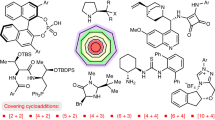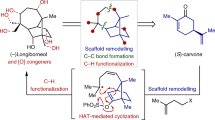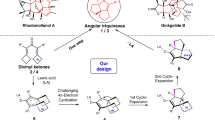Abstract
Synthetic organic strategies that enable the catalytic and rapid assembly of a large array of organic compounds that possess multiple stereocentres in acyclic systems are somewhat rare, especially when it comes to reaching today’s high standards of efficiency and selectivity. In particular, the catalytic preparation of a three-dimensional molecular layout of a simple acyclic hydrocarbon skeleton that possesses several stereocentres from simple and readily available reagents still represents a vastly uncharted domain. Here we report a rapid, modular, stereodivergent and diversity-oriented unified strategy to construct acyclic molecular frameworks that bear up to four contiguous and congested stereogenic elements, with remarkably high levels of stereocontrol and in only three catalytic steps from commercially available alkynes. A regio- and diastereoselective catalytic Heck migratory insertion reaction of alkenylcyclopropyl carbinols that merges selective C–C bond cleavage of a cyclopropane represents the key step.
This is a preview of subscription content, access via your institution
Access options
Access Nature and 54 other Nature Portfolio journals
Get Nature+, our best-value online-access subscription
$29.99 / 30 days
cancel any time
Subscribe to this journal
Receive 12 print issues and online access
$259.00 per year
only $21.58 per issue
Buy this article
- Purchase on Springer Link
- Instant access to full article PDF
Prices may be subject to local taxes which are calculated during checkout





Similar content being viewed by others
References
Burrows, C. J. Holy grails in chemistry, part II. Acc. Chem. Res. 50, 445 (2017).
Gaich, T. & Baran, P. S. Aiming for the ideal synthesis. J. Org. Chem. 75, 4657–4673 (2010).
Burns, N. Z., Baran, P. S. & Hoffmann, R. W. Redox economy in organic synthesis. Angew. Chem. Int. Ed. 48, 2854–2867 (2009).
Wender, P. A., Verma, V. A., Paxton, T. J. & Pillow, T. H. Function-oriented synthesis, step economy, and drug design. Acc. Chem. Res. 41, 40–49 (2008).
Baran, P. S., Maimone, T. S. & Richter, J. M. Total synthesis of marine natural products without using protective groups. Nature 446, 404–408 (2007).
Trost, B. M. The atom economy—a search for synthetic efficiency. Science 254, 1471–1477 (1991).
Lovering, F., Bikker, J. & Humblet, C. Escape from the flatland: increasing saturation as an approach to improving clinical success. J. Med. Chem. 52, 6752–6756 (2009).
Böttcher, T. An additive definition of molecular complexity. J. Chem. Inf. Model. 56, 462–470 (2016).
de Vries, J. G., Molander, G. A., Evans, P. A. Stereoselective Synthesis in Science of Synthesis (Thieme, Stuttgart, 2011).
Carreira, E. & Kvaerno, L. Classics in Stereoselective Synthesis (Wiley-VCH, Weinheim, 2009).
Burns, M. et al. Assembly-line synthesis of organic molecules with tailored shapes. Nature 513, 183–188 (2014).
Krautwald, S., Sarlah, D., Schafroth, M. A. & Carreira, E. M. Enantio- and diastereodivergent dual catalysis: α-allylation of branched aldehydes. Science 340, 1065–1068 (2013).
Quasdorf, K. W. & Overman, L. E. Catalytic enantioselective synthesis of quaternary stereocentres. Nature 516, 181–191 (2014).
Das, J. P. & Marek, I. Enantioselective synthesis of all-carbon quaternary stereogenic centers in acyclic systems. Chem. Commun. 47, 4593–4623 (2011).
Trost, B. M. & Jiang, C. Catalytic enantioselective construction of all-carbon quaternary stereocenters. Synthesis369–396 (2006).
Douglas, C. J. & Overman, L. E. Catalytic asymmetric synthesis of all-carbon quaternary stereocenters. Proc. Natl Acad. Sci. USA 101, 5363–5367 (2004).
Corey, E. J. & Guzman-Perez, A. The catalytic enantioselective construction of molecules with quaternary stereocenters. Angew. Chem. Int. Ed. 37, 388–401 (1998).
Trabocchi, A. (ed) Diversity-Oriented Synthesis: Basics and Applications in Organic Synthesis and Chemical Biology (John Wiley and Sons, Hoboken, 2013).
O’Connor, C. J., Beckmann, H. S. G. & Spring, D. R. Diversity-oriented synthesis: producing chemical tools for dissecting biology. Chem. Soc. Rev. 41, 4444–4456 (2012).
Burke, M. & Schreiber, S. A planning strategy for diversely-oriented synthesis. Angew. Chem. Int. Ed. 43, 46–58 (2004).
Marek, I. et al. All-carbon quaternary stereogenic centers in acyclic systems through the creation of several C–C bonds per chemical step. J. Am. Chem. Soc. 136, 2682–2694 (2014).
Kulinkovich, O. G. Cyclopropanes in Organic Synthesis (John Wiley & Sons, Hoboken, 2015).
Schneider, T. F., Kaschel, J. & Werz, D. B. A new golden age for donor–acceptor cyclopropanes. Angew. Chem. Int. Ed. 53, 5504–5523 (2014).
Rubin, M., Rubina, M. & Gevorgyan, V. Transition metal chemistry of cyclopropenes and cyclopropanes. Chem. Rev. 107, 3117–3179 (2007).
Reissig, H.-U. & Zimmer, R. Donor–acceptor-substituted cyclopropane derivatives and their applications in organic synthesis. Chem. Rev. 103, 1151–1196 (2003).
Wong, H. N. C. et al. Use of cyclopropanes and their derivatives in organic synthesis. Chem. Rev. 89, 165–198 (1989).
Ebner, C. & Carreira, E. M. Cyclopropanation strategies in recent total syntheses. Chem. Rev. 117, 11651–11679 (2017).
Lebel, H., Marcoux, J.-F., Molinaro, C. & Charette, A. B. Stereoselective cyclopropanation reactions. Chem. Rev. 103, 977–1050 (2003).
Fumagalli, G., Stanton, S. & Bower, J. F. Recent methodologies that exploit C–C single bond cleavage of strained ring systems by transition metals. Chem. Rev. 117, 9404–9432 (2017).
Murakami, M. & Chatani, N. Cleavage of Carbon–Carbon Single Bonds by Transition Metals (Wiley-VCH, Weinheim, 2016).
Souillart, L. & Cramer, N. Catalytic C–C bond activation via oxidative addition to transition metals. Chem. Rev. 115, 9410–9464 (2015).
Marek, I., Masarwa, A., Delaye, P.-O. & Leibeling, M. Selective carbon–carbon bond cleavage for the stereoselective synthesis of acyclic systems. Angew. Chem. Int. Ed. 54, 414–429 (2014).
Dong, G. (ed) C–C Bond Activation (Springer, Berlin, 2014).
Ruhland, K. Transition-metal-mediated cleavage and activation of C–C single bonds. Eur. J. Org. Chem. 2012, 2683–2706 (2012).
Murakami, M. & Matsuda, T. Metal-catalysed cleavage of carbon–carbon bonds. Chem. Commun. 47, 1100–1105 (2011).
Roy, S. R., Didier, D., Kleiner, A. & Marek, I. Diastereodivergent combined carbometalation/zinc homologation/C–C fragmentation reaction as an efficient tool to prepare acyclic allylic quaternary carbon stereocenters. Chem. Sci. 7, 5989–5994 (2016).
Zhang, F.-G., Eppe, G. & Marek, I. Brook rearrangement as a trigger for the ring opening of strained carbocycles. Angew. Chem. Int. Ed. 55, 714–718 (2016).
Vasseur, A., Perrin, L., Eisenstein, O. & Marek, I. Remote functionalization of hydrocarbons with reversibility enhanced stereocontrol. Chem. Sci. 6, 2770–2776 (2015).
Simaan, M., Delaye, P.-O., Shi, M. & Marek, I. Cyclopropene derivatives as precursors to enantioenriched cyclopropanols and n-butenals possessing quaternary carbon stereocenters. Angew. Chem. Int. Ed. 54, 12345–12348 (2015).
Masarwa, A. et al. Merging allylic carbon–hydrogen and selective carbon–carbon bond activation. Nature 505, 199–203 (2014).
Delaye, P.-O., Didier, D. & Marek, I. Diastereodivergent carbometalation/oxidation/selective ring opening: formation of all-carbon quaternary stereogenic centers in acyclic systems. Angew. Chem. Int. Ed. 52, 5333–5337 (2013).
Simaan, S. & Marek, I. Hydroformylation reaction of alkylidenecyclopropane derivatives: a new pathway for the formation of acyclic aldehydes containing quaternary stereogenic carbons. J. Am. Chem. Soc. 132, 4066–4067 (2010).
Simaan, S., Goldberg, A. F. G., Rosset, S. & Marek, I. Metal-catalyzed ring-opening of alkylidenecyclopropanes: new access to building blocks with an acyclic quaternary stereogenic center. Chem. Eur. J. 16, 774–778 (2010).
Singh, S., Bruffaerts, J., Vasseur, A. & Marek, I. A unique Pd-catalysed Heck arylation as a remote trigger for cyclopropane selective ring-opening. Nat. Commun. 8, 14200 (2017).
Oestreich, M. Directed Mizoroki–Heck reactions. Top. Organomet. Chem. 24, 169–192 (2007).
Katsuda, Y. Progress and future in pyrethroids. Top. Curr. Chem. 314, 1–30 (2012).
Jiao, L. & Yu, X. Vinylcyclopropane derivatives in transition-metal-catalyzed cycloadditions for the synthesis of carbocyclic compounds. J. Org. Chem. 78, 6842–6848 (2013).
Müller, D. S. et al. Tandem hydroalumination/Cu-catalyzed asymmetric vinyl metalation as a new access to enantioenriched vinylcyclopropane derivatives. Org. Lett. 19, 3970–3973 (2017).
Dian, L., Müller, D. S. & Marek, I. Asymmetric copper-catalyzed carbomagnesiation of cyclopropenes. Angew. Chem. Int. Ed. 56, 6783–6787 (2017).
Lou, M. et al. A new chiral Rh(ii) catalyst for enantioselective [2+1]-cycloaddition. Mechanistic implications and applications. J. Am. Chem. Soc. 126, 8916–8918 (2004).
Didier, D. et al. Modulable and highly diastereoselective carbometalations of cyclopropenes. Chem. Eur. J. 20, 1038–1048 (2014).
Mei, T.-S., Werner, E. W., Burckle, A. J. & Sigman, M. S. Enantioselective redox-relay oxidative Heck arylations of acyclic alkenyl alcohols using boronic acids. J. Am. Chem. Soc. 135, 6830–6833 (2015).
Mei, T.-S., Patel, H. H. & Sigman, M. S. Enantioselective construction of remote quaternary stereocentres. Nature 508, 340–344 (2014).
Patel, H. H. & Sigman, M. S. Enantioselective palladium-catalyzed alkenylation of trisubstituted alkenols to form allylic quaternary centers. J. Am. Chem. Soc. 138, 14226–14229 (2016).
Zhang, C., Santiago, S. B., Crawford, J. M. & Sigman, M. S. Enantioselective dehydrogenative Heck arylations of trisubstituted alkenes with indoles to construct quaternary stereocenters. J. Am. Chem. Soc. 137, 15668–15671 (2015).
Le Bras, J. & Muzart, J. Intermolecular dehydrogenative Heck reactions. Chem. Rev. 111, 1170–1214 (2011).
Larionov, E., Lin, L., Guénée, L. & Mazet, C. Scope and mechanism in palladium-catalyzed isomerizations of highly substituted allylic, homoallylic, and alkenyl alcohols. J. Am. Chem. Soc. 136, 16882–16894 (2014).
Dang, Y., Qu, S., Wang, Z.-X. & Wang, X. A computational mechanistic study of an unprecedented Heck-type relay reaction: insight into the origins of regio- and enantioslectivities. J. Am. Chem. Soc. 136, 986–998 (2014).
Xu, L. et al. Mechanism, reactivity, and selectivity in palladium-catalyzed redox relay Heck arylations of alkenyl alcohols. J. Am. Chem. Soc. 136, 1960–1967 (2014).
Hilton, M. J. et al. Investigating the nature of palladium chain-walking in the enantioselective redox-relay Heck reaction of alkenyl alcohols. J. Org. Chem. 79, 11841–11850 (2014).
Lin, L., Romano, C. & Mazet, C. Palladium-catalyzed long-range deconjugative isomerization of highly substituted α,β-unsaturated carbonyl compounds. J. Am. Chem. Soc. 138, 10344–10350 (2016).
Dupuy, S. et al. Selective functionalization of alkyl chains by regioconvergent cross-coupling. Angew. Chem. Int. Ed. 55, 14793–14797 (2016).
Acknowledgements
This research was supported by the Israel Science Foundation administrated by the Israel Academy of Sciences and Humanities (330/17) and by the European Research Council under the European Community’s Seventh Framework Program (ERC grant agreement no. 338912). I.M. is holder of the Sir Michael and Lady Sobell Academic Chair.
Author information
Authors and Affiliations
Contributions
J.B., D.P. and I.M. planned the research. J.B. and D.P. conducted and analysed experiments. I.M. directed the project, and wrote the manuscript with contributions from J.B. and D.P. All the authors discussed the results and commented on the manuscript.
Corresponding author
Ethics declarations
Competing interests
The authors declare no competing interests.
Additional information
Publisher’s note: Springer Nature remains neutral with regard to jurisdictional claims in published maps and institutional affiliations.
Supplementary information
Supplementary Information
Detailed experimental procedures with full descriptions of all molecules and complete NMR data of all new compounds
Crystallographic data
CIF for compound 6a; CCDC reference: 1813305
Crystallographic data
CIF for compound 6b; CCDC reference: 1813312
Rights and permissions
About this article
Cite this article
Bruffaerts, J., Pierrot, D. & Marek, I. Efficient and stereodivergent synthesis of unsaturated acyclic fragments bearing contiguous stereogenic elements. Nature Chem 10, 1164–1170 (2018). https://doi.org/10.1038/s41557-018-0123-7
Received:
Accepted:
Published:
Issue Date:
DOI: https://doi.org/10.1038/s41557-018-0123-7
This article is cited by
-
Stereoselective synthesis through remote functionalization
Nature Synthesis (2022)
-
Palladium-catalyzed regio- and enantioselective migratory allylic C(sp3)-H functionalization
Nature Communications (2021)
-
A unified approach for divergent synthesis of contiguous stereodiads employing a small boronyl group
Nature Communications (2020)
-
Stereodivergent assembly of tetrahydro-γ-carbolines via synergistic catalytic asymmetric cascade reaction
Nature Communications (2019)
-
Easy as one, two, three
Nature Chemistry (2018)



